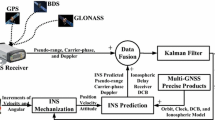Abstract
Chinese Area Positioning System (CAPS) is a transmitted satellite navigation system moved by the Chinese Academy of Sciences. Three basic modes of navigation and positioning with CAPS are given, and then a comparative analysis is made in this paper. In terms of the principle that the ionospheric delay is at an inverse ratio to the frequency square, a new ionospheric-free positioning method based on a double-antenna CAPS receiver is put forward. Then the hybrid differential observations and the solving equations and algorithms for one epoch and multi epochs are deduced according to the basic principle of the method. The method may remove the global errors in signal emission, propagation, transmission and receiving (e.g., ionospheric delay, hardware delay, and clock error). So it is very convenient for the single-epoch solution and multi-epoch navigation and positioning, and may efficiently improve the precision of real time CAPS navigation. Furthermore, the method can be used not only for the geometric orbit determination of CAPS GEO and IGSO satellites and the navigation and positioning, but also for the estimation of the tropospheric zenith delay, which is useful for the study of water vapor changes in the atmosphere. Polynomials are used in this method to express the tropospheric zenith delay and CAPS satellite orbits within the limited time interval, which reduces the number of unknown parameters and thus speeds the computation.
Similar content being viewed by others
References
Ai G X, Shi H L, Wu H T, et al. The principal of the positioning system based on communication satellites. Sci China Ser G-Phys Mech Astron, 2009, 52(3): 472–488
Shi H L. Principle of Transmitted Satellite Navigation. Beijing: Chinese Academy of Sciences, 2004
Zheng Z F. Key algorithm of new China astronomical position system. Thesis for Master Degree. Xi’an: Xidian University, 2004
Wu H T, Bian Y J, Lu X C, et al. Time syncronization and carrier frequency control of CAPS navigation signals generated on the ground. Sci China Ser G-Phys Mech Astron, 2009, 52(3): 393–401
Lu X C, Wu H T, Bian Y J, et al. Signal structure of the Chinese Area Positioning System. Sci China Ser G-Phys Mech Astron, 2009, 52(3):412–422
Li X H, Wu H T, Bian Y J, et al. Satellite virtual atomic clock with pseudorange difference function. Sci China Ser G-Phys Mech Astron, 2009, 52(3): 353–359
Yang X H, Li Z G, Feng C G, et al. Methods of rapid orbit forecasting after maneuvers for geostationary satellites. Sci China Ser G-Phys Mech Astron, 2009, 52(3): 333–338
Leick A. GPS Satellite Surveying. 3rd ed. Hoboken: John Wiley & Sons, 2004
Zhou Z M, Yi J J, Zhou Q. GPS Satellite Surveying Principle and Applications. 2nd ed. Beijing: Surveying and Mapping Press, 1997
Guo J Y, Chang X T, Yue Q. Study on curved surface fitting model using GPS leveling in local area. Trans Nonferrous Met Soc China, 2005, 15: 140–144
Han Y B, Ma L H, Qiao Q Y, et al. Selection of satellite constellation framework of CAPS. Sci China Ser G-Phys Mech Astron, 2009, 52(3):458–471
Guo J Y, Hwang C W, Tzeng Z P, et al. Geometric orbit determination of COSMIC from satellite-borne non-difference GPS data. Prog Nat Sci, 2008, 18(1): 75–80
Ji Y F. Study on GPS/CAPS software receiver design and multi path effect. Doctor Dissertation. Beijing: Chinese Academy Sciences, 2008
Li Z G, Yang X H, Shi H L, et al. A new method for determination of satellite orbits by transfer. Sci China Ser G-Phys Mech Astron, 2009, 52(3): 384–392
Guo J Y. Determination of Low-orbit Satellite Orbit and Earth Gravity Field Model with Satellite-borne GPS Technique. Xi’an: Xi’an Mapping Press, 2006
Tao H X, Guo J Y. Unknown parameter’s variance-covariance propagation and calculation in generalized nonlinear least squares problem. J Coal Sci Eng Chin, 2005, 11(1): 52–55
Niell A E. Global mapping functions for the atmosphere delay at radio wavelengths. J Geophys Res, 1996, 101(B2): 3227–3246
Author information
Authors and Affiliations
Corresponding author
Additional information
Supported by the Knowledge Innovation Project of the Chinese Academy of Sciences (Grant No. KGCX1-21), the National Basic Research Program of China (Grant No. 2007CB815500), the National High Technology Research and Development Program of China (Grant No. 2006AA12z303), the National Natural Science Foundation of China (Grant No. 40774009), and the Special Project of Taishan Scholars of Shandong Province of China (Grant No. TSXZ0502)
Rights and permissions
About this article
Cite this article
Guo, J., Han, Y. & Chang, X. A new method of ionospheric-free hybrid differential positioning based on a double-antenna CAPS receiver. Sci. China Ser. G-Phys. Mech. Astron. 52, 368–375 (2009). https://doi.org/10.1007/s11433-009-0054-9
Received:
Accepted:
Published:
Issue Date:
DOI: https://doi.org/10.1007/s11433-009-0054-9




